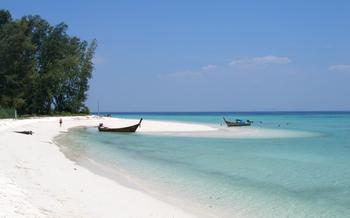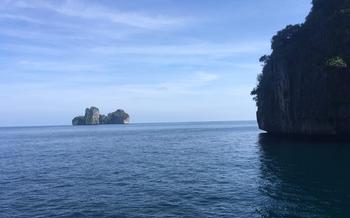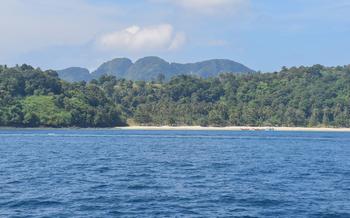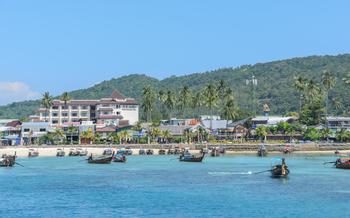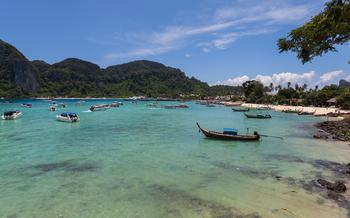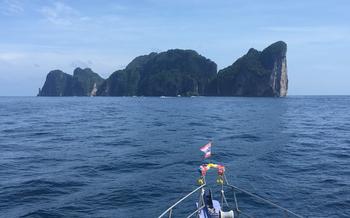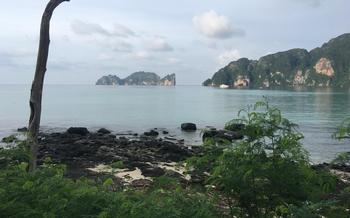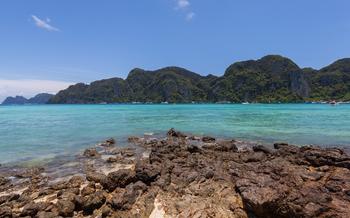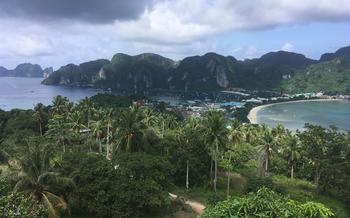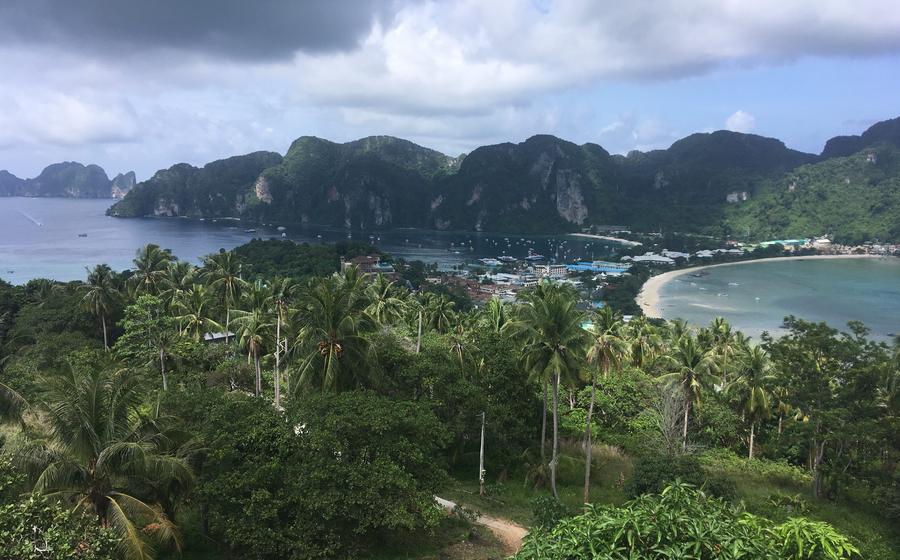
Phi Phi Climbers
- Phi Phi Islands: A Climber's Paradise
- Exploring the Climbing Scene
- Climbing Highlights
- The Phi Phi Islands offer a diverse range of climbing experiences, catering to climbers of all levels. Here are some of the must-visit climbing destinations on the islands:
- Intermediate Climbers
- Multi-Pitch Climbing Adventures
- Challenging Overhangs and Cracks
- Building Endurance and Strength
- Advancing Climbing Skills
- Training and Fitness
- Safety First
- Respecting the Environment
- Best Time to Visit
- Planning Your Trip
- Where to Stay
- What to Bring
- Food and Dining
Phi Phi Islands: A Climber's Paradise
Nestled in the heart of Thailand's Andaman Sea, the Phi Phi Islands offer a climber's paradise, attracting enthusiasts from around the world. With towering limestone cliffs, a diverse range of climbing routes, and breathtaking views, Phi Phi is a dream destination for those seeking adventure and stunning scenery.
Location and accessibility: The Phi Phi Islands are located approximately 40 kilometers east of Phuket, easily accessible by boat from Phuket or Krabi. The main island, Phi Phi Don, serves as the hub for climbing activities, with several climbing schools, guides, and equipment rental shops catering to climbers of all levels.
Unique limestone cliffs: The islands are renowned for their unique limestone cliffs, formed over millions of years by the erosion of coral reefs. These towering cliffs, often adorned with lush vegetation and cascading waterfalls, create a picturesque backdrop for climbing adventures.
Variety of climbing routes: Phi Phi offers a wide variety of climbing routes to suit climbers of all abilities. From beginner-friendly top-rope climbs to challenging multi-pitch routes and technical overhangs, there's something for everyone to enjoy.
Stunning views: The combination of stunning views and challenging climbs makes Phi Phi an unforgettable destination for climbers. Whether you're scaling a cliff overlooking the turquoise waters of Maya Bay or ascending a towering pinnacle with panoramic views of the surrounding islands, the scenery is simply breathtaking.
Exploring the Climbing Scene
Phi Phi's climbing scene is a vibrant and welcoming community. It has a rich history, dating back to the 1970s when climbers such as John "Jack" Shea, Pierre Tardivel, and Eric Jones first explored the islands' limestone cliffs. Their pioneering efforts laid the foundation for the modern climbing scene, attracting climbers from all over the world to experience the unique challenges and beauty of Phi Phi's rock faces.
Today, the local climbing community is thriving, with a diverse mix of experienced climbers, aspiring beginners, and everything in between. The islands are home to a number of climbing schools and guiding services, offering courses, guided climbs, and equipment rental for climbers of all levels. These schools provide expert instruction, ensuring that climbers have the skills and knowledge necessary to safely navigate the islands' challenging terrain.
Climbing Highlights
The Phi Phi Islands offer a diverse range of climbing experiences, catering to climbers of all levels. Here are some of the must-visit climbing destinations on the islands:
-
Ton Sai Tower: This iconic limestone pinnacle is a true test of strength and endurance. Known for its steep overhangs and technical climbing routes, Ton Sai Tower is a popular challenge among experienced climbers. The summit offers breathtaking views of the surrounding islands and the Andaman Sea.
-
Maya Bay: Located in the heart of the Phi Phi Islands, Maya Bay is a postcard-perfect destination for climbers and beach lovers alike. The towering limestone cliffs that surround the bay provide ample opportunities for rock climbing, while the crystal-clear waters offer a refreshing respite after a challenging climb.
-
Loh Samah Bay: This secluded bay is home to a series of multi-pitch climbing routes that offer stunning views of the surrounding islands. The limestone cliffs in Loh Samah Bay are known for their sharp cracks and pockets, making them ideal for technical climbing.
-
Viking Cave: For a truly unique climbing experience, head to Viking Cave. This sea cave offers a variety of climbing routes that lead through the cave's interior and out onto the open cliffs. Climbers can enjoy the cool shade of the cave while marveling at the stunning views of the surrounding ocean.
Intermediate Climbers
Intermediate climbers in Phi Phi are ready to take on more challenging routes and push their limits. With a solid foundation in the basics, they can now explore multi-pitch climbs, navigate overhangs and cracks, and build endurance and strength.
Multi-Pitch Climbing Adventures
Multi-pitch climbing involves ascending a series of pitches, each requiring a separate belay. This adds an element of adventure and endurance to the climb, as intermediate climbers learn to manage their energy and work together as a team.
Challenging Overhangs and Cracks
Overhangs and cracks provide a unique challenge for intermediate climbers. Overhangs require climbers to use their upper body strength and technique to pull themselves up, while cracks test their finger strength and placement skills.
Building Endurance and Strength
Intermediate climbers should focus on building endurance and strength to tackle longer and more challenging routes. This can be achieved through regular climbing practice, strength training exercises, and finger training to improve grip strength.
Advancing Climbing Skills
As intermediate climbers progress, they can begin to refine their techniques, learn new skills, and develop their own climbing style. This includes mastering belay techniques, practicing lead climbing, and experimenting with different types of climbing gear.
Training and Fitness
To excel in rock climbing, training and fitness are crucial. Embrace warm-up and stretching routines to prepare your body for the physical demands of climbing. Engage in strength and conditioning exercises to enhance your overall strength, power, and endurance. Don't forget the importance of finger training and grip strength, as they play a vital role in your climbing performance. By maintaining peak performance, you'll be able to tackle challenging routes with confidence and ease.
Safety First
Climbing in Phi Phi, like any adventure sport, carries inherent risks. To ensure a safe and enjoyable experience, prioritize safety above all else. Utilize proper safety gear, including a helmet, harness, and sturdy ropes. Inspect your equipment regularly to identify and address any wear or damage. Master belay techniques and maintain effective communication with your climbing partner. Familiarize yourself with common climbing mistakes and take steps to avoid them, such as overestimating your abilities or neglecting proper safety protocols. By prioritizing safety, you can minimize risks and maximize your enjoyment of Phi Phi's climbing adventures.
Respecting the Environment
Rock climbers have a responsibility to protect and preserve the natural beauty of the climbing areas they visit. Leave No Trace principles should be followed, such as packing out all trash and leaving the environment as it was found. Climbers should also be mindful of their impact on the delicate ecosystem, avoiding disturbing wildlife and damaging vegetation.
Supporting sustainable tourism practices is another way to protect the environment. Climbers can choose to stay in eco-friendly accommodations, patronize local businesses that support conservation efforts, and minimize their carbon footprint by walking, biking, or taking public transportation instead of driving.
The fragile ecosystem of the Phi Phi Islands is particularly vulnerable to the impacts of tourism. Climbers should be mindful of their actions and take steps to minimize their impact on the environment. By following Leave No Trace principles, supporting sustainable tourism practices, and respecting the natural beauty of the islands, climbers can help to ensure that the Phi Phi Islands remain a pristine climbing destination for generations to come.
Best Time to Visit
The best time to visit Phi Phi Islands for rock climbing is during the dry season, which runs from November to April. During this time, the weather is generally stable and dry, with minimal rainfall and optimal climbing conditions. The temperatures are also pleasant, averaging between 25°C and 30°C, making it ideal for outdoor activities.
Peak season falls between December and February, when the islands are bustling with tourists and climbers. While this can be a vibrant and lively time to visit, it also means that the climbing areas can be crowded. If you prefer a more tranquil experience, consider visiting during the shoulder months of November or April, when the crowds are smaller, and the weather is still favorable for climbing.
During the rainy season (May to October), climbing conditions can be unpredictable, with frequent downpours and humid weather. While it's still possible to climb during this time, be prepared for wet and slippery conditions, and keep an eye on the weather forecast before heading out. Some climbing routes may be inaccessible or unsafe due to heavy rains.
Planning Your Trip
Organizing a climbing trip to Ko Phi Phi requires careful planning to ensure a smooth and enjoyable experience. Here are some key considerations:
-
Choosing the Right Time of Year: Aim for the dry season, typically from November to April, for the best climbing conditions. During this period, the weather is stable, with minimal rainfall and moderate humidity, providing optimal grip and friction on the limestone cliffs.
-
Booking Accommodation and Transportation: Book your accommodation and transportation in advance, especially if traveling during peak season. Phi Phi is a popular tourist destination, and availability can be limited. Explore options ranging from budget-friendly hostels to luxurious resorts to suit your budget and preferences.
-
Packing Essential Climbing Gear: Ensure you bring all the necessary climbing gear, including a harness, helmet, shoes, chalk bag, and belay device. If you don't have your own equipment, rental options are available on the island. Pack comfortable clothing and footwear suitable for climbing, as well as sunscreen, insect repellent, and a first-aid kit.
-
Budgeting for Expenses: Plan a budget that covers accommodation, transportation, climbing gear rental (if needed), food, and other activities. Climbing courses or guided tours can add to the cost, so factor that in if you're a beginner or prefer professional instruction.
Where to Stay
Phi Phi Islands offers a diverse range of accommodation options to suit every budget and preference.
For budget-conscious travelers, there are numerous hostels and guesthouses that provide basic yet comfortable rooms at affordable prices. These establishments often have a communal atmosphere, allowing guests to connect with fellow climbers and share their experiences.
Mid-range resorts and bungalows offer a step up in comfort and amenities, with private rooms, air conditioning, and sometimes even balconies with stunning views of the surrounding scenery. These resorts often have swimming pools, restaurants, and other facilities to enhance your stay.
For those seeking a luxurious experience, there are several upscale resorts and private villas available on the islands. These accommodations offer the ultimate in comfort and exclusivity, with spacious rooms, private pools, and personalized services. Some even have their own rock climbing walls or direct access to the best climbing spots.
Regardless of your budget or preferences, you'll find a range of accommodation options on the Phi Phi Islands that will make your climbing trip a memorable one.
What to Bring
Packing the right gear is essential for a successful climbing trip to Ko Phi Phi. Start with a comprehensive climbing equipment checklist that includes the following items:
-
Climbing Shoes: Choose comfortable and well-fitting climbing shoes that provide good support and friction.
-
Harness: Ensure your harness is in good condition and fits snugly without restricting movement.
-
Belay Device: Bring a reliable belay device that you're familiar with using.
-
Ropes: Pack a dynamic rope of appropriate length for your chosen climbing routes.
-
Quickdraws: Bring a set of quickdraws for clipping into anchors and building belay stations.
-
Helmet: Protect your head with a lightweight climbing helmet that meets safety standards.
-
Chalk Bag: Keep your hands dry and improve grip with a chalk bag and chalk.
In addition to climbing gear, pack comfortable clothing and footwear suitable for climbing. Opt for breathable and flexible clothing that allows for freedom of movement. Pack sturdy hiking boots or approach shoes for accessing climbing areas.
Don't forget essential items like sunscreen, insect repellent, and a first-aid kit. Stay hydrated and energized with a water bottle and snacks during your climbing sessions. Consider bringing a headlamp if you plan to climb at night or in caves.
Food and Dining
After a day of exhilarating climbs, satisfy your appetite with the delectable culinary offerings of Ko Phi Phi. From authentic Thai cuisine to international fare, the island boasts a diverse range of dining options. Indulge in the flavors of Pad Thai, a classic stir-fried noodle dish, or savor the spicy kick of a fiery green curry. For seafood enthusiasts, freshly caught fish and succulent prawns await, grilled to perfection and served with aromatic rice.
Embrace the laid-back beach vibe and dine alfresco at one of the many beachfront restaurants. As you savor your meal, let the gentle sea breeze caress your skin and gaze out at the breathtaking views of the limestone cliffs. Vegetarian and vegan travelers will also find a haven of culinary delights on Ko Phi Phi, with an array of restaurants catering to their dietary preferences.
To truly immerse yourself in the local culture, venture beyond the main tourist areas and explore the hidden gems of Ko Phi Phi's food scene. Ask the locals for recommendations and uncover small, family-run eateries that serve up authentic Thai dishes at unbelievably affordable prices. No matter your budget or taste, Ko Phi Phi has something to satisfy every palate, ensuring that your culinary journey is as memorable as your climbing adventures.
